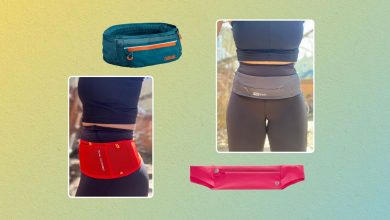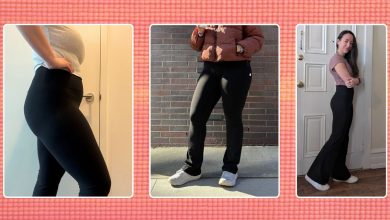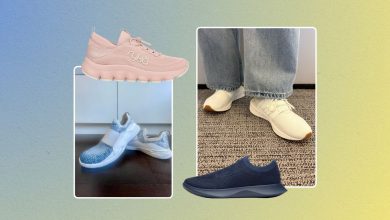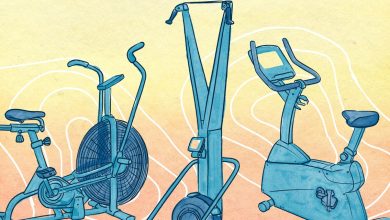Hiking with Plantar Fasciitis Doesn’t Have to Hurt—These Boots Prove It
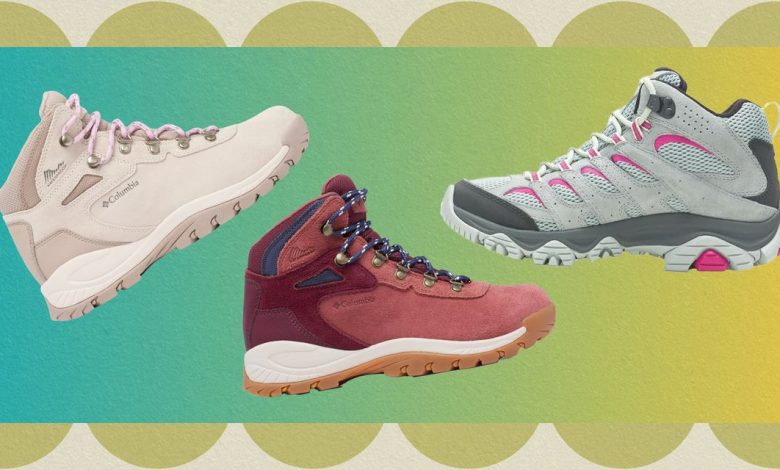
Anyone who deals with plantar fasciitis knows the pain that can come from wearing ill-fitting shoes—and that discomfort can be even worse when you’re trying to get through a challenging hike in a bad pair of boots. Since plantar fasciitis can affect folks with all sorts of foot types (flat, wide, narrow), there’s no single best hiking boot for the condition. That said, podiatrists do have a few general guidelines for staying pain-free as you embark on outdoor adventures.
“Someone who suffers from plantar fasciitis needs extra rigidity in the midsole and cushioning in the midfoot to prevent overstretching and decrease impact on the heel, which is where many experience pain,” Nelya Lobkova, DPM, board-certified podiatrist and founder of Step Up Footcare in New York City, tells SELF. So a shoe with a thick, stable, and supportive midsole is important for anyone who dreams of telling their plantar fasciitis to take a hike—shop our favorites below.
Our top picks
- Best Overall: Hoka Kaha 3 GTX
- Runner Up: Keen Targhee IV Mid Hiking Boots
- Best Budget Pick: Columbia Newton Ridge Plus Hiking Boot
- Best for Winter: Danner Mountain 600 Hiking Boot
- Best for Ankle Support: Kuru Quest
- Best for Custom Orthotics: Merrell Moab 3 Mid Hiking Boots
- Best Lightweight: Salomon Cross Hike 2 Mid Gore-Tex Hiking Boots
- Best for Long Treks: Oboz Katabatic Mid Waterproof
Shop the best hiking boots for plantar fasciitis
To keep your feet comfortable from mile one to mile ten, it’s important to pick the right shoes—here are our very favorite pairs.
Best Overall: Hoka Kaha 3 GTX
Pros
- Maximum cushioning
- Wide, stable heel
- Waterproof
Cons
- Pricey
- Heavier than other options
Multiple experts recommended the previous version of this boot, the Kaha 2 waterproof, to SELF for its lightweight design, highly cushioned midsole, and wide heel that supports the area where plantar fasciitis pain can flare. Hoka’s latest iteration, the Kaha 3, performs well on the trail too, with a treaded rubber outsole that provides plenty of traction, plus a durable rubber toe cap that keeps sticks, rocks, and other debris at bay.
The waterproof Gore-Tex upper was made for hiking in less-than-ideal weather. Also key: the shoe’s flexible, Achilles-friendly collar, which adds stability while taking the pressure off of your heel.
One Hoka loyalist said the Kaha 3s definitely hold up against her other pairs: “I was happy to find that the hiking boots are as comfortable as my regular Hoka shoes,” she wrote in a review. “They’re also very warm.”
Sizes: US 5 to 11 | Widths: Medium | Heel-to-toe drop: 7 millimeters | Weight: 16.8 ounces
Runner Up: Keen Targhee IV Waterproof Mid
Keen
Targhee IV Waterproof Mid
Pros
- Lots of padding around the ankle
- Great arch support
- Deep lugs for solid traction
- Breathable mesh lining
Cons
- Heavy, can feel a little bulky
Whether the itinerary calls for backpacking, scrambling up a steep incline, or strolling along a dirt path, the Keen Targhee IV boot is up to the task. Reviewers report wearing them for everything from hiking through moving water to braving the daily conditions of a Chicago winter without any heel pain. “I especially like the high-quality cushioning along the ankle and the nice arch support inside, which is great for plantar fasciitis,” one wrote.
They’re highly protective, thanks to an abrasion-resistant outsole; a high-traction, multidirectional lug pattern; and a durable leather upper. But the mesh lining keeps them breathable too (because swampy feet can put a real damper on any kind of trek).
Sizes: 5 to 12 | Widths: Medium | Heel-to-toe drop: 12 millimeters | Weight: 16.58 ounces
Best Budget Pick: Columbia Newton Ridge Plus Hiking Boot
Columbia
Newton Ridge Plus Hiking Boot
Pros
- Waterproof
- Hook-and-loop closure system means no knots
- Springy midsole won’t weigh you down
Cons
- Runs slightly large, according to reviewers
The Columbia Newton Ridge Plus is another fantastic (and budget-friendly, as far as hiking gear goes) waterproof hiking boot that comes with lots of glowing reviews from folks with plantar fasciitis.
“Bought for our first Cub Scout weekend camping trip. I have plantar fasciitis and insertional Achilles tendonitis on my left foot—but these were comfortable and supportive for all the walking/hiking we did that weekend,” one reviewer wrote. Its highly cushioned footbed is made to keep feet feeling invigorated, even on a long haul.
Sizes: US 5 to 12 | Widths: Medium, wide | Heel-to-toe drop: 19.05 millimeters | Weight: 13.8 ounces
Best for Winter: Danner Mountain 600 Hiking Boots
Danner
Mountain 600 Hiking Boots
Pros
- Outsole is flexible, but still has solid traction
- Waterproof
- Roomy enough to fit custom orthotics
Cons
- Heavy
- Not the widest size range
- Expensive
Designed to withstand the year-round elements of the Pacific Northwest, Danner’s Mountain 600 hiking boots aim to keep your feet warm and dry with its waterproof suede upper and grippy rubber outsole.
According to one Zappos reviewer, they’re also pretty darn durable: “I’ve had these boots for almost three years now. They are so durable and comfortable through all seasons and definitely kept my feet warm in harsh cold temperatures,” they wrote. These are also a good choice if you’re someone who likes to use your own insoles: “I have some significant plantar fasciitis, and these boots are so comfortable. They can accommodate my custom orthotics,” they added.
Sizes: US 6 to 11 | Widths: Medium | Heel-to-toe drop: N/A | Weight: 16 ounces
Best for Ankle Support: Kuru Quest
Pros
- Good shock absorption
- Midsole is designed to cradle your heel
- A little lighter than some other boots on our list
Cons
- Sole doesn’t have very deep lugs for traction
- Not waterproof
- Expensive
Kuru’s shoes are designed to address a variety of foot conditions, including plantar fasciitis, and its Quest hiking boot is a bestseller. From its shock-absorbing, contoured insole to its unique heel cradle, it aims to alleviate your pain step after step.
While we’ve talked a lot about your heels, your ankles deserve some extra support too. “It’s very important for me to have ankle stability,” wrote one reviewer, who has undergone ankle fusion and knee replacements. “These have been my favorite and most comfortable shoes I own, and the only pair I wear. I can move with confidence.”
Note: The Quest does lack some of the more technical features we like to see in a truly versatile hiking boot (like an extra-protective toe cap and deep lugs in the sole), so if you’re planning on tackling some challenging terrain, consider one of the other options on our list.
Sizes: US 6 to 12 | Widths: Medium | Heel-to-toe drop: 12 millimeters | Weight: 14.06 ounces
Best for Custom Orthotics: Merrell Moab 3 Mid Hiking Boots
Merrell
Moab 3 Mid Hiking Boots
Pros
- Very comfortable
- Absorbs shock well
- Great traction
Cons
- May run small
Merrell’s rugged Moab 3 boot is an upgrade to previous iterations—it’s “extremely comfortable regardless of terrain and length of hike,” Myriam Bishop, a backpacking guide for Wildland Trekking Company, previously told SELF. That goes for people with plantar fasciitis too: The Moab 3 has a heel cup that’s great at absorbing shock and a super grippy rubber outsole to keep you feeling sturdy and stable on the trails.
Use orthotic inserts and don’t want to hike without them? You’re in luck: The Moab 3 has a removable insole, so you can slip yours right inside.
According to a number of reviewers, there’s no “break-in” period required for these, either: “I love these boots. They were comfortable right out of the box, and I quickly took them to the Adirondack High Peaks and did several long rugged hikes,” one reviewer wrote.
Sizes: US 5 to 12 | Widths: Medium, wide | Heel-to-toe drop: 11.5 millimeters | Weight: 13.57 ounces
Best Lightweight: Salomon Cross Hike 2 Mid Gore-Tex Hiking Boots
Salomon
Cross Hike 2 Mid Gore-Tex Hiking Boots
Pros
- You can tighten the laces with one pull
- Tabs on the heels make them easy to slip on and off
- Surprisingly lightweight, for a boot
Cons
- Laces tend to come loose, according to some reviewers
- Pricey
With a waterproof membrane made from Gore-Tex, deep lugs to grip steep inclines, and a shaft that fits snugly around your ankle, this Salomon hiking boot is ready for anything—from inclement weather to truly difficult trails.
Previously recommended to SELF by Sydney Williams, the founder of Hiking My Feelings, the Cross Hike 2 has a springy foam midsole and a rigid structure that will help you feel supported, even when the terrain gets rocky. She’s worn them for thousands of miles, noting that it feels more like a trail running shoe than a stiff, clunky boot.
Sizes: US 5.5 to 11 | Widths: Medium and wide | Heel-to-toe drop: 10 millimeters | Weight: 12.7 ounces
Best for Long Treks: Oboz Katabatic Mid Waterproof
Oboz
Katabatic Mid Waterproof
Pros
- Waterproof
- Sleek, colorful design
- Comes with a one-year limited warranty
Cons
- Some reviewers say it could use some more arch support
- Pricey
These hiking boots from Oboz are designed to stabilize and protect your feet, without you needing to slow down or take a break in the name of foot pain. And according to a number of happy customers who wore them comfortably for long periods, they deliver.
“I love these shoes,” wrote one reviewer. “I work on my feet outside daily for eight-plus hours, and they are the only shoes that keep my feet from having bouts of plantar fasciitis.” Another reviewer wore the Katabatics on a three-day hiking trip during treks between five and nine miles long: “I wore them on two hot, sandy desert hikes, and one cold, wet mountain hike, and they had great traction on both,” they wrote.
Sizes: US 5 to 12 | Widths: Medium | Heel-to-toe drop: 8 millimeters | Weight: 13.4 ounces
What is plantar fasciitis?
Your plantar fascia is a thick band of tissue that stretches along the bottom of your foot from your heel bone up to your toes, Paulina Piekarska, DPM, a foot and ankle specialist and surgeon at Hartford HealthCare Connecticut Orthopaedic Institute at St. Vincent’s Medical Center, tells SELF. She adds that it’s critical for proper arch support and plays an important role in your overall gait (or the way you walk).
Plantar fasciitis occurs when that tissue becomes inflamed where it attaches to your heel, often due to overuse or excessive force, Dr. Piekarska says. When that happens, you may feel a sharp, stabbing, or even burning pain in your heel (and sometimes other parts of your foot too). The pain is most likely to flare up in the mornings or when getting up after spending a while off your feet, according to the Mayo Clinic, but Dr. Piekarska says it can sometimes persist throughout the day.
Any weight-bearing activity, including standing, walking, running, and, yes, hiking, can exacerbate plantar fasciitis symptoms, Dr. Piekarska says. If you’re dealing with an acute plantar fasciitis flare-up—or don’t want to risk dealing with a lot of pain and soreness after your outing—consider resting and rescheduling your outdoor adventure for another day, Arthur Belanger, DPM, a podiatrist at Holston Medical Group in Johnson City, Tennessee, tells SELF.
How to choose the best hiking boots for plantar fasciitis
You may need to try on a few boots to find the right pair—but a little trial and error is worth avoiding chafing, irritation, blisters, and pain in the long run. In addition to making sure your boots feel comfortable (an important first step for all hikers, not just those with foot issues), here are a few features to consider.
The toe box refers to the front of the shoe, where your forefoot sits. The toe box should offer enough space for you to wiggle your toes, says Dr. Belanger—make sure it isn’t too narrow or tight.
The heel counter is the back of the shoe—it should be firm enough to keep your foot stable as you move, which can help minimize plantar fasciitis pain, says Dr. Lobkova. Still, Dr. Belanger adds, the heel counter shouldn’t feel restrictively tight, or it may cause blisters (ouch).
Dr. Pierkarska says you should look for a fairly stiff hiking boot: “The more flexible the shoe, the less support the joints in your foot have,” she explains. “[A flexible shoe] requires the plantar fascia, as well as your joints and ligaments, to accommodate your body weight with each step, since the shoe is doing little to no work.”
Dr. Lobkova agrees: “The midsole of a shoe is the part that touches the ground and determines how forces transfer from the ground to the feet,” she says, adding that people with plantar fasciitis benefit from an extra-firm midsole to stabilize the foot and prevent the plantar fascia from overstretching.
Having a slight heel drop (meaning the difference in height between the forefoot and heel is around 10 millimeters) is also helpful for preventing pain related to plantar fasciitis, Dr. Belanger says. Most shoes on our list fall into this category.
How we picked these boots
First, we asked podiatrists for their expert shopping advice on how to find a boot that feels good when you’re dealing with plantar fasciitis pain. We used their tips, along with countless online reviews, to pull a pool of foot-friendly hiking boots. SELF testers also tried several models out on the trails themselves. Only the pairs that were comfortable, well-made, and easy to wear made the final cut.
FAQs about shopping for hiking boots for plantar fasciitis
Is it okay to walk long distances when I have plantar fasciitis?
The short answer? “Walking has a low impact on the feet, so it should be well tolerated for someone with plantar fasciitis wearing the right shoes,” says Dr. Lobkova. But she warns that you might want to hang up your boots for a beat if you’re in the midst of healing from an acute plantar fasciitis flare-up.
Which boots should I avoid if I have plantar fasciitis?
“The most important hiking boot to avoid is a zero-drop boot, which has the same distance between both the ground and the ball of the foot and also the ground and the heel,” says Dr. Lobkova. She says these shoes can strain the Achilles tendon and plantar fascia.
“It’s also advised to avoid boots with a thin midsole, since minimum cushioning under the heel places maximum stress on the heel bone,” she adds. “All of these factors could exacerbate pre-existing plantar fasciitis.”
